It's the time of year for reflection, and with that comes our annual look back at the longest home runs of the season. The hypothesis remains the same: The majority of long homers come as a result of elevated pitches that badly miss their targets.
Home runs are the stepchildren of the True Outcome family. Whereas strikeouts and walks can occur with the hitter leaving his bat on his shoulder, home runs require a batter to swing the lumber and utilize his stick-wielding skills in order to come to fruition. This reality absolves the pitcher of some of the responsibility for homers, but the prevailing tendency for big blasts to result from poorly executed pitches still leaves the man on the mound left to absorb much of the blame.
Before we get started, it's worth noting that the zone charts (from www.BrooksBaseball.net) which are used in the following examples reflect the catcher's point of view, so the orientation of the strike zone is flipped when compared to the videos and pictures that are provided for each pitch. We will also be using the keypad nomenclature to divvy up the strike zone one-through-nine for pitch target and location, such that the zone is diced into a 3×3 matrix that has “one” at the upper-left corner of the viewing window (pitcher's POV), the “five” in the middle of the zone, and the “nine” located in the lower-right corner (down-in to a right-handed batter), just like a telephone keypad.
Without further ado, let's take a look at the eight longest home runs of 2014.
Date: April 12
Pitcher: Jon Pettibone
Distance: 469 feet
Stanton had a monster season, leading the National League in homers en route to the NL Hank Aaron Award. His prolific power materialized in quality as well as quantity, from low lasers to long-distance drives. His long fly against Jonathan Pettibone was the eighth-longest homer of the season and Stanton's first of two bombs on the day. Pettibone tried to locate a change-up low and away from Stanton, with catcher Carlos Ruiz set-up behind the number seven of the strike zone keypad.
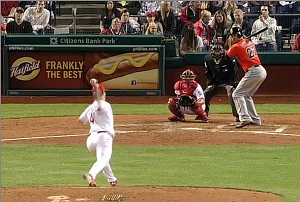
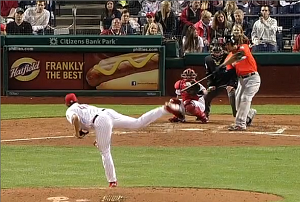
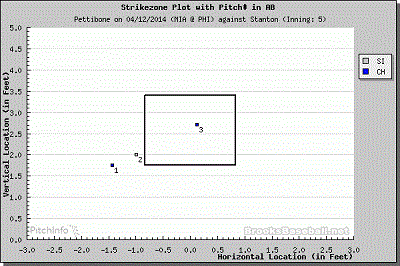
Target: 7
Location: upper 5
Unfortunately for Pettibone, the pitch was badly elevated and drifted back over the heart of the plate, essentially served on a silver platter to the eagerly-waiting Stanton. The pitch was a classic example of under-rotation, with a late arm that perpetuated the pitch that missed up and to the arm side of his target. The theory of elevated pitches receives another data point in its favor.
6. (tie) Paul Goldschmidt
Date: May 28
Pitcher: Troy Patton
Distance: 470 feet
Goldschmidt had a monster follow-up to his breakout campaign of 2013, posting MVP-caliber numbers until an Ernesto Frieri fastball smashed his hand in a rare pinch-hitting appearance on August 1st, prematurely ending Goldy's season. He had 19 homers when he went down, the furthest of which was this 470-foot moonshot that hit more than halfway up the batter's eye in dead center field. Goldschmidt feasted off of left-hander's like Troy Patton this season, continuing a career trend that has seen Goldschmidt post a platoon split that is 150 points of OPS higher versus southpaws.
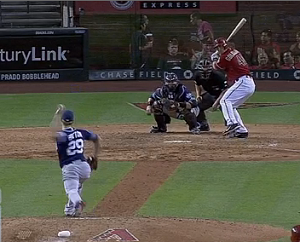

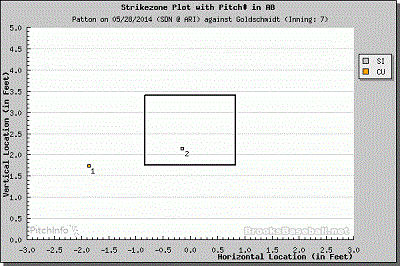
Target: border of 7 and 8
Location: 8, drifting toward 9
The critical pitch was not elevated at all, and it just missed the target that was set up on the border between the numbers seven and eight of the strike zone keypad. The sinker finished down in the zone, but it drifted over the middle third of the plate and slid into the no. 8 key (where Goldschmidt had a .714 slugging percentage on balls in play), and the Arizona first baseman dropped the hammer.
6. (tie) Stanton
Date: August 11
Pitcher: Shelby Miller
Distance: 470 feet
This third-inning blast was already Stanton's second home run of the game off of Shelby Miller, with a distance reading that dwarfed that of his first drive by a good 90 feet. Stanton was finishing off a home-run barrage, as this was his fifth deep fly in the past five ball games. As an aside, the Miami camera feed offers one of the best views on television, with a setup that is directly behind the pitcher to reduce the parallax and allow for a truer lateral reading for evaluating mechanics or pitch location.

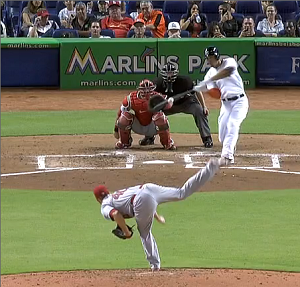

Target: below 7
Location: 3, veering toward 5
Miller started the at-bat by staying far away from Stanton, avoiding the hitter's strengths while painting the outer edge of the strike zone. Miller hept the plan intact for four pitches, but on the fifth offering he lost his release point. The catcher was set up low and away, below the number seven on the keypad, with the intent of burying a curveball on the 2-2 pitch. However, the right-hander badly under-rotated into release point to leave a hanger up and in to Stanton, floating up to the number three of the strike zone before the Marlin outfielder destroyed the baseball.
Date: June 8
Pitcher: Jorge De La Rosa
Distance: 472 feet
Hanley has not been the devastating force that he was in 2013, but on June 8th the stars aligned for him to hit one of the longest home runs of the year. Ramirez has hit lefties better throughout his career, including a .393 lifetime batting average in 28 at-bats versus De La Rosa, and the thin air of Denver helped to extend the flight path of this big blast. From the department of fun facts, I have used the term “elevator” to describe this series as well as the robotic leg lift of De La Rosa, whose abrupt pattern comes straight from the Tower of Terror.
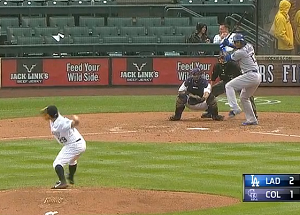

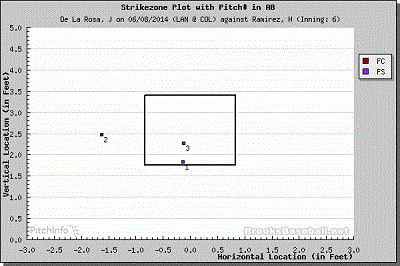
Target: below the border of 7 and 8
Location: Upper 8, drifting toward 5
For his part, De La Rosa stuck to the script by elevating this pitch above the intended location, which was designed to be a near-repeat of his first-strike split, instead leaving the splitter up in the meatball zone of district five. A split-fingered fastball that is elevated evaporates its effectiveness, and one that catches too much plate often suffers the same fate of long-distance travel. Throwing such a pitch to Hanley Ramirez is a near-certain disaster, as the free-agent shortstop thrives on off-speed pitches, with a career slugging percentage of .582 against changeups and splits (83 points higher than any other pitch category) and a .705 mark in 2014.
4. Justin Upton
Date: April 10
Pitcher: Jenrry Mejia
Distance: 477 feet
Upton had an outstanding April for the second consecutive season, and though he started slowly for the team's first eight games, the two-homer day on April 10th was the domino that kick-started his boomstick. The 477-foot shot in the third inning was Upton's second deep fly against Mejia in as many innings, out-traveling the previous homer by 98 feet and triggering a run of 13 hits (four of them homers) over a span of four games. The camera feed from Atlanta provides another one of the better angles in the league, with a view from straightaway center field that isolates pitch location.


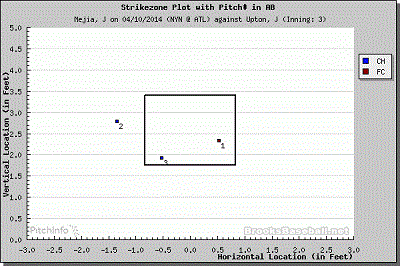
Target: on the border of 7 and 8
Location: 9
Similar to Hanley Ramirez, Justin Upton is a hitter who excels at mashing the changeup, as he proved on this pitch from Mejia. Now the Mets closer, but having begun the season in a starting role, Mejia initiated the at-bat with a fastball that stayed away from Upton and generated an empty swing, followed by a changeup that missed the zone inside on the right-handed hitter. Mejia followed with another cambio, this one aimed toward the border of sectors seven and eight on the strike zone key pad, but Mejia let the pitch drift into the inner third where Upton was able to jump on it. Elevation was less of an issue in this case, but a missed target that was supposed to keep the ball away from Upton ended up veering into his wheelhouse.
3. David Ortiz
Date: April 22
Pitcher: Masahiro Tanaka
Distance: 482 feet
Big Papi just keeps plugging along, and though his batting average dropped about 50 points from the plateau that he had established from 2011 to '13, his monstrous power remained intact. He has corrected the platoon issues that plagued him earlier in his career, to the extent that Ortiz hit southpaws better than right-hander's this season, but his towering drive off of Masahiro Tanaka was yet another reminder that Ortiz can hit anything.
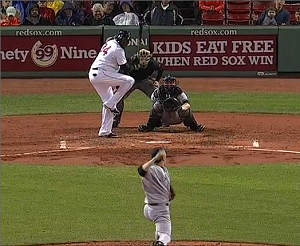


Target: 9
Location: 8, drifting toward 9
Tanaka stayed away from Papi throughout the plate appearance, coming inside just once on a pitch that was out of each (reminder that the above zone is from the catcher's POV). He caught more of the white on his fifth pitch, and though Tanaka was within spitting distance of his target and kept the pitch on the lower shelf, the pitch location on the middle third of the horizontal zone was pounced upon by Ortiz. Tanaka gets away with that pitch more often than not, but Papi is an exceptional hitter who was able to take advantage of the one pitch that he saw that wasn't tucked into a corner of the zone. This pitch was not badly elevated, and the horizontal location was not an egregious error, but Tanaka lost out to an excellent hitter who can drive a pitch whether or not it is a mistake.
2. Stanton
Date: April 4
Pitcher: Eric Stults
Distance: 484 feet
This is Stanton's third entry among the eight longest home runs of the year and the third listing in a row that occurred in the opening weeks of the season. It occurred just eight days prior to his 469-foot rocket off of Jon Pettibone and was Stanton's second home run of the campaign. It was also his first off of a left-handed pitcher in 2014, setting the tone for a season in which he slaughtered southpaws to the tune of a .343/.445/.630 line across 128 plate appearances. It was all in a day's work for L.L. Cool G, because Lefties Loathe Cool Giancarlo.
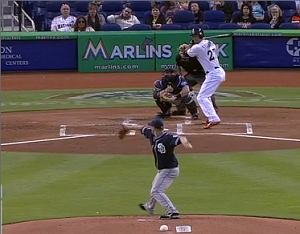

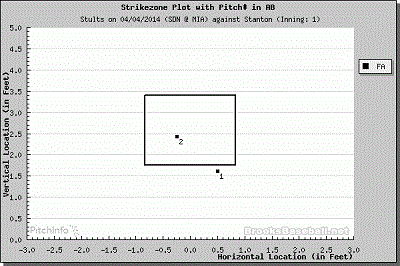
Target: 9
Location: border of 5 and 6
After the first-pitch fastball finished below the zone, the catcher was set up down and in to Stanton for another fastball on pitch number two. Backstop Yasmani Grandal was stationed behind keypad number nine, but Eric Stults under-rotated the pitch with a late arm that triggered a missed target that was badly elevated and which veered toward the middle of the zone, finishing on the border of keypad numbers five and six. Stults does not throw especially hard, placing more of a premium on pitch location, and bad things happen when he leaves 89-mph fastballs over the heart of the plate against one of the best power hitters in the game.
1. Mike Trout
Date: June 27
Pitcher: Jason Vargas
Distance: 489 feet
It's only fitting that the most exciting ballplayer in the game mashed the deepest drive of the 2014 season, topping off a season that will likely end in a long-anticipated MVP Award for Trout. He hits pretty much everybody, though it is worth noting that Trout has a reverse platoon split thus far in his career (which stayed true this season), so the longest homer of 2014 was not just a case of the game's best player exploiting optimal circumstances. The ball was hit in a tough ballpark for home runs, though park dimensions cease to matter in these cases, and Vargas was near the league average in terms of his vulnerability to the long ball.
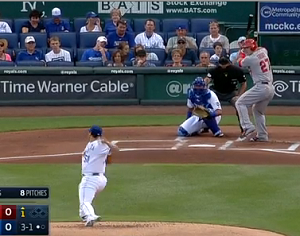
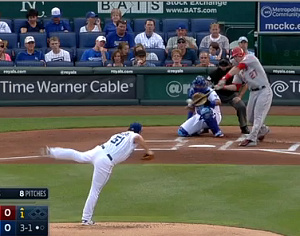
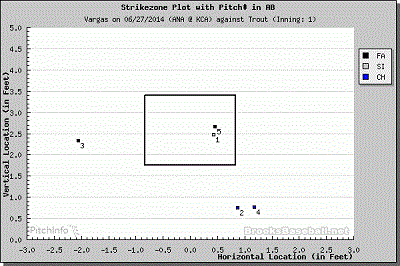
Target: border of 7 and 8
Location: border of 4 and 5
Vargas was all over the place in this at bat, getting away with a first-pitch sinker that caught too much plate before losing his release point for three straight deliveries. He fell behind 3-1 and came back in the strike zone with a fastball, and Trout was geared up, unloading on the pitch with a quick, compact stroke that sent the baseball soaring off into the fountain. Catcher Sal Perez had setup his target on the border of keys seven and eight, trying to keep the ball down and away from Trout, but Vargas committed the cardinal sin of pitch elevation, badly missing his low-shelf target before Trout left the building.
***
All told, five of the eight longest homers of 2014 were hit on pitches that were badly elevated, allowing opposing hitters to get under the ball and yank it out of the yard. Interestingly, the three other blasts came on pitches that stayed low in the zone, with the common ingredient of missed targets that leaked out over the plate or played into the hitter's hands. Under-rotation was the most common mechanical symptom, resulting in pitches that missed up and to the arm-side of their intended locations. This factor is consistent with past evaluations and casts a foreboding shadow over the popular use of quick-pace strategies such as the slide step, as such techniques commonly result in late arms and elevated pitches, leaving pitchers vulnerable to crooked numbers on the scoreboard.
Thank you for reading
This is a free article. If you enjoyed it, consider subscribing to Baseball Prospectus. Subscriptions support ongoing public baseball research and analysis in an increasingly proprietary environment.
Subscribe now
Who were the catchers for these various homers? One can't help but think that at least in some cases, they share some responsibility for what happened.
6a. Yasmani Grandal
6b. A.J. Pierzynski
5. Wilin Rosario
4. Travis d'Arnaud
3. Brian McCann
2. Yasmani Grandal
1. Salvador Perez
And for those (like me) who were wondering about Harper's huge HR off Hunter Strickland in the NLDS, the official distance was "only" 445 ft, good for right around 90th place.